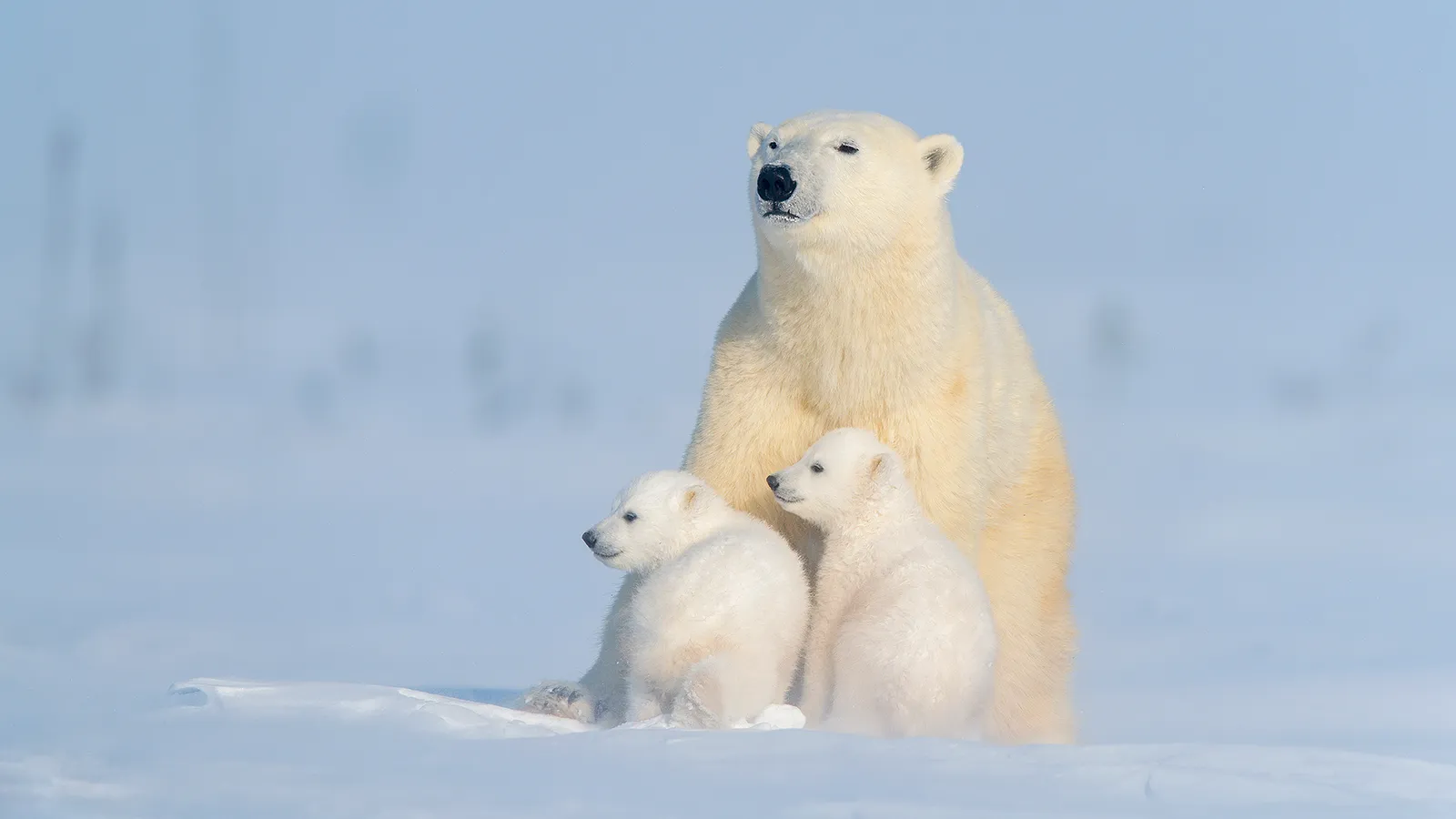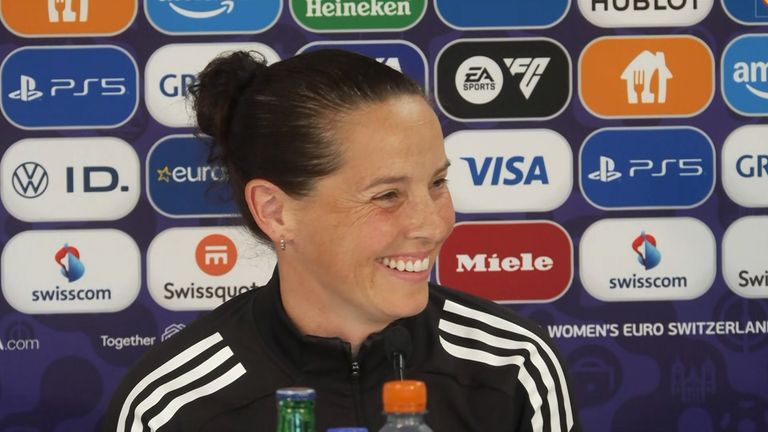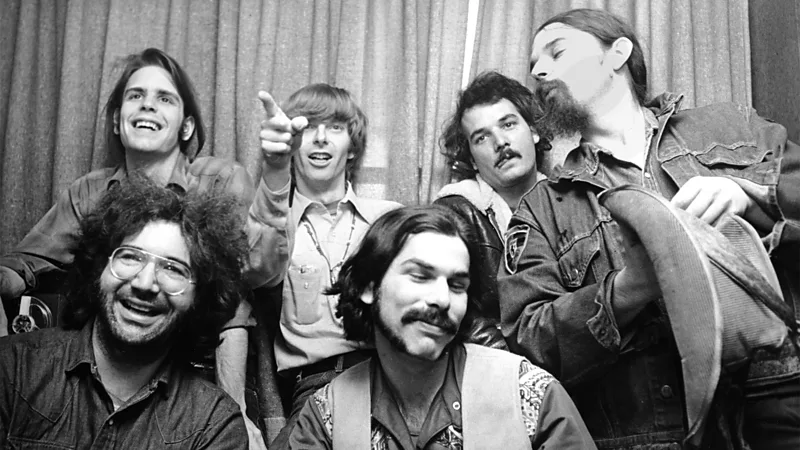Why polar bears are no longer the poster image of climate change
For decades distressed polar bears on distant ice caps were an emblem for climate change – until experts began to doubt the effectiveness of these visuals.

In a derelict hunting camp in the Baffin Islands, Northern Canada, photographers Cristina Mittermeier and Paul Nicklen watched in horror as a polar bear took what were likely its last steps.
With mangey, discoloured fur and a gaunt frame the bear dragged its feet, taking slow and laboured movements. At one point, it paused, to scavenge for food in an abandoned barrel – chewing on the foam seat of a snowmobile, which had been burned and tossed away.
"It was so heartbreaking to watch this animal, probably in its last few minutes of life," said Mittermeier, who shot what would later become one of the decade's most viral – and controversial – polar bear images.
In December 2017, her image, and Nicklen's accompanying video footage, were published in National Geographic Magazine, overlaid with subtitles suggesting: "This is what climate change looks like". The scene in the Baffin Islands became a sensation, quickly clocking up an estimated 2.5 billion views, and fuelling a global discussion about the threat of melting ice caps and global warming.
Images of distressed polar bears clinging to ice floes or in far-flung Arctic landscapes have become instantly recognisable as emblems for the climate crisis. However, over the last decade, scientists, campaigners and news desks have begun to drift away from these visuals, questioning if they really paint a realistic image of climate change.
Imagery that was once hauntingly attention-grabbing was criticised for being too distant, unrelatable and devastating, prompting a call for more diverse representations of climate change. Popular media began to shift away from these iconic photos, opting instead for images of extreme weather, such as heatwaves, droughts and typhoons, which emphasise an issue far closer to home.
Although experts are in agreement that ice caps are melting at record rates, some have warned that images of distressed polar bears might not tell the full story.
Sea ice concentrations have declined by 13% each decade since 1979 due to increasing global temperatures. In 2023, sea ice in Antarctica is well below any previous recorded winter level – a benchmark that the National Snow and Ice Data Center recently termed "mind blowing".
One victim of this change are polar bears, who spend less time on sea ice, leading them to fast for longer, become thinner and have fewer cubs. But Michael Pritchard, a photo-historian at the Royal Photographic Society in the UK, warns that taking shocking polar bear photos at face value can be "problematic."
"We need to think about the context in which it was taken, how it was taken, and why it was taken. They say the photograph never lies. Well, actually, it can tell a very different story to reality," he says.
A photograph can tell a different story to reality – Michael Pritchard
In response to criticism that circled Mittermeier's starving polar bear photo, which suggested other factors such as cancer could be at play, National Geographic issued a statement to say it had "gone too far" by making the link between the dying polar bear and climate change.
In a subsequent op-ed for National Geographic, Mittermeier described how she had "lost control of the narrative" as the image went viral. However, as the co-founder of SeaLegacy, a climate campaign organisation, she reflected that she hadn't intended to make a scientific assertion, but to create a talking point.
"When scientists say polar bears are going to starve to death in the Arctic because of the loss of sea ice, this is what it's going to look like," she says. "[Polar bears] are not just a number on a spreadsheet. We were hoping that was going to have an impact on the conversation."
Similar to iconic images such as the 1972 "Napalm Girl",' which became a defining symbol of the war in Vietnam and swayed public opinion, she says striking visuals can alter the discourse.
"I really wanted this photograph to become a moment in which we stopped to recognise that climate change is an existential threat to humanity, and it starts with animals," she adds.
Paradoxical visuals
Although polar bears may have once been shorthand for climate change, experts have argued they have lost their value as climate symbols – misrepresenting an entire species and distancing the immediate threat of climate disaster.
On the one hand, polar bear images can be a compelling tool to inspire donations from sympathetic audiences, says Pritchard. Similar to the panda, which became a beloved symbol for nature conservation and the mascot for the World Wildlife Fund (WWF) in 1961, the polar bear became a hallmark for a world people wanted to protect.
"They're seen as cute and cuddly, and as a result, they appeal to people instantly, whether that's for fundraising purposes or raising awareness of a particular issue," says Pritchard. "If people used a fish or amphibian, it wouldn't have the same popular appeal."
Saffron O'Neill, an expert in climate and society at the University of Exeter in the UK, traced the saturation of polar bear images in news and popular science media. Her study indicated this was a particularly marked trend in the UK. Polar bear visuals averaged between 2% and 6% of climate visual news coverage during the period 2000–2010, with some newspapers in later years achieving over double this quantity of coverage.
O'Neill also carried out a study on 30 UK participants, who spontaneously mentioned polar bears when asked for the first images that came to mind when thinking about climate change.
However, Kate Manzo, a lecturer in climate change communication at Newcastle University in the UK, calls these "paradoxical visuals" – images that have conflicting messages. Manzo says one of the problems with these campaigns is that they misrepresent polar bears, which are not "little white fluffy toys".
She uses the example of anti-poverty campaigns of malnourished African children that were widespread in charity brochures and TV commercials. "Images of starving children with flies around their faces are very emotionally powerful images, and people often hand over money to help NGOs, but they also reinforce all sorts of problematic colonial stereotypes," she says.
With polar bear images, there is a risk of alienating the public by implying that the issue is removed from their reality. Stereotypical images of the Arctic – that are icy, blank, so remote it appears otherworldly – create a sense that climate change is a distant problem. "The focus on this iconic visual can exclude the wider realities of climate change. It misses the essential perspectives of indigenous Arctic communities, for example" says O'Neill.
"It is impossible to rely on a single symbol to represent a global problem with local effects," says Manzo. A more relatable visual is extreme weather, she says. Last summer's images of floods sweeping the UK, as well as tourists fleeing heatwaves in Greece and wildfires in Canada, show that it's increasingly difficult to outsource the problem. "Climate change is close to home now. We need to find other ways of attracting attention to the climate crisis," Manzo says.
People not polar bears
In the 2010s, campaigns by the non-profits Oxfam and Christian Aid began to shift away from traditional images, advocating for "people not polar bears". Later, news desks followed suit, by publishing editorials pledging to move away from defaulting to polar bear images in their climate change coverage.
In 2019, Fiona Shields, picture editor at the Guardian newspaper, said the paper would be moving away from polar bears as illustrations of the climate emergency, classing them "an obvious – though not necessarily appropriate – choice".
Shields cited tight deadlines, a limited photo database, and the struggle to depict what can appear an invisible crisis, as reasons coverage has leaned so heavily on traditional symbols such as the polar bear.
As media outlets have begun searching for alternative images many have turned to Climate Visuals, an evidence-based climate photography resource founded in 2017 by Climate Outreach.
The organisation provides an image library of photos that media or non-profits can use either for free, or for a small license fee. These conform to the seven principles of climate communication, the first, being "show real people".
In a study conducted by Climate Visuals, 17 images were selected and tested with six focus groups in Germany, as well as through a representative survey with a sample of the German population. The study found that polar bear photos are iconic, but not sufficiently compelling.
"You're better off showing a more human interaction with climate change, something that people can relate to," says Alastair Johnstone, the climate visuals advisor at Climate Outreach.
There are no images of polar bears in their database, instead, images of the Arctic circle are of climate scientists or indigenous peoples with detailed captions, credit information and an explanation of why it fits in their evidence base.
CARBON COUNT
The emissions from travel it took to report this story were 0kg CO2. The digital emissions from this story are an estimated 1.2g to 3.6g CO2 per page view. Find out more about how we calculated this figure here.
Telling new stories is also a key principle. "There's an issue with image fatigue. A lot of people will be familiar with polar bear images," says Johnstone. Moving away from tired images is a chance to offer hope. "If you marry emotionally powerful images with solutions-based photography, people have a more detailed connection to the image," he adds.
This chimes with a wider trend of "conservation photography," which showcases both the beauty of, and in many cases, the threats to our environment. Although Mittermeier said she stood by her iconic starving polar bear shot, her visuals have become increasingly solutions-orientated. In 2023, her cover for Time Magazine celebrated the recovery of a damaged coral reef in a marine conservation zone in Baja, Mexico.
"If you look at my body of work in general, it's more of an aspiration to the kind of planet that we would like to live in," she says. "It encourages us to take action, encouraging us to participate, as opposed to confronting us with the horrors constantly."
-bbc







